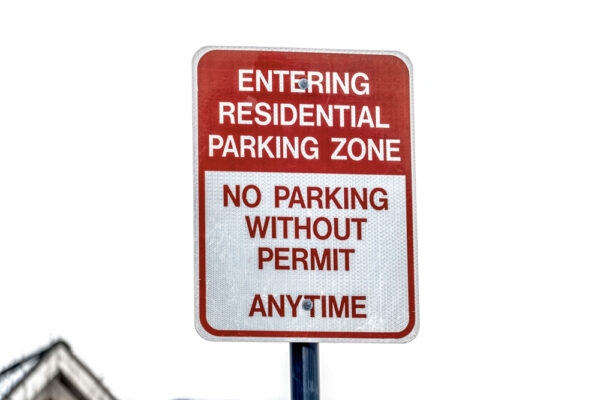As an owner of rental properties, whether you specialize in single-family homes, apartment complexes, or both, tenant parking is something you have to address. After all, it may be the deciding factor in a potential renter’s final decision. You can invest a ton of time and energy in making your properties safe, comfortable, and attractive, but if there’s no place to park, tenants might take their search elsewhere. But don’t worry: we’ve outlined all the important aspects of rental property parking so you don’t have to.
On-Street vs. Off-Street vs. Offsite Parking
Based on my own past experience as a renter in search of the perfect place, I can tell you that adequate and convenient parking was always near the top of my list of desired amenities, and I typically boiled it down to two different categories: on-street and off-street parking. On-street parking is just that: parking spaces that are located right on the street, usually open to the public and therefore not necessarily available on a consistent basis. Off-street parking is also just what it sounds like, but it can mean a few different things: driveways, parking lots, and garages all qualify as off-street parking, and these latter two can be either private or available for public use.
If your properties (whether single-family homes or apartments) aren’t accompanied by driveways, parking lots, parking stalls, or parking garages that you own and personally oversee, then your tenants are essentially on their own when it comes to securing parking for their vehicles, but that doesn’t mean your job is over when it comes to parking. There are still ways to appeal to potential renters who place a premium on parking (of which there are many).

In the event that you don’t offer traditional parking to your tenants, you should still take the time to research the area surrounding your properties, as there may be offsite opportunities you can leverage to your benefit. If there are parking garages nearby, consider including their location and pricing information in your promotional materials, as it might help sway a renter on the fence. You can even look into implementing tandem parking or partnering with a valet parking service. Get creative!
Assigned vs. Unassigned Parking for your Rental Properties
If you do offer some form of private, off-street parking to your tenants, you’ll still need to decide how to organize and manage it. One thing to consider is whether you will assign individual parking spots to your tenants.
The simplest, most hands-off approach is to opt for unassigned parking. While this equates to little work on your end in terms of actually overseeing the day-to-day goings-on related to parking, it’s a good idea to research local regulations to make sure your parking situation is up to code. Ordinances in your city may require a minimum number of parking spaces per dwelling unit, and not complying with those ordinances could mean hefty fines or penalties, not to mention disgruntled renters fighting over a scarcity of parking spots.
Depending on the neighborhood in which your rental properties are located, assigned parking could be considered a prized amenity (and one whose value might even allow you to raise rental rates). If you have property in a more rural area, or a less densely-populated suburb in which there is already plenty of easily accessible on-street parking, assigned off-street parking may be less of a sticking point for tenants.

If you do opt for assigned parking, you can either assign a certain number of specific parking spots to each unit, or you can designate a cluster of parking spots for a number of different units (i.e., tenants living in Building A are permitted to park in any of the 12 spots in Lot A). Lastly, it’s important to note that if you don’t have some form of penalty in place for those renters (or non-renters) who violate your rental parking policy, your carefully planned parking arrangement will quickly turn into a free-for-all. This means that your lease agreement (or parking addendum—more on that later) must state what those penalties are, and you’ll need to put up clear signage on your properties to avoid confusion. And when violations do occur, you’ll need to enforce the rules you’ve made, otherwise your policy will gain the reputation of having more bark than bite.
Covered vs. Uncovered Rental Parking
Another chief concern of renters is whether the parking you provide will protect their vehicles from the elements (and from thieves and vandalism). If you do provide off-street parking, you’ll also need to decide whether to offer covered or uncovered spaces.
As with unassigned parking, uncovered parking is the simpler (and less expensive) option, but it won’t provide as much of a draw to tenants, especially in areas with particularly harsh winters or higher crime rates. Offering covered parking may allow you to raise rental rates (or charge an additional monthly fee by way of a separate parking addendum), and you’ll be able to advertise this offering in your promotional materials, making your property even more attractive to potential tenants. If you do end up opting for covered parking, you might consider bolstering the area with lights, cameras, and/or some form of security, such as a keycard- or passcode-accessible gate. These are the kinds of bells and whistles that will set your properties apart from other landlords.
Single-Family Homes and Driveways
If you’re a property manager dealing primarily in single-family homes with traditional driveways, you may be wondering if any of this article applies to you. In fact, it does: parking is still a critical component of your business, and you need to give it the attention it deserves.

As mentioned earlier, there may be local rules and regulations in place that require property owners to provide a minimum number of parking spaces per dwelling unit, and this doesn’t necessarily just apply to owners of apartment complexes. On a related note, even if you provide the legal minimum number of parking spaces, the parking arrangement might still be inadequate in terms of its relation to the surrounding area, and this inadequacy can present hazards to both your renters and to other drivers and pedestrians. Pay close attention to the driveways of your rental properties, and do what you can to protect yourself from potential liability risks.
Rental Parking Addendums
As with nearly every other aspect of property management, you’ll want to put down your parking expectations and policies in writing, with clear and precise language. In this case, you’ll most likely want to integrate a separate parking addendum into your lease-signing process.
We’ve discussed on-street vs. off-street, assigned vs. unassigned, and covered vs. uncovered parking, as well as the potential use of valet services and keycard/passcode entry. Whatever combination of these you choose to go with, you can use a parking addendum to flesh out exactly how you expect your tenants to utilize parking areas. Other important items to include in a solid parking addendum include a liability clause, language about who’s responsible for repairs and maintenance, details regarding guest and handicap parking, and (should you opt for assigned parking) the consequences for parking violations. After signing their leases, your new tenants should walk away with a thorough understanding of when, how, and where they can park their vehicles.
Anything found written in this article was written solely for informational purposes. We advise that you receive professional advice if you plan to move forward with any of the information found. You agree that neither Lula or the author are liable for any damages that arise from the use of the information found within this article

Great guide! Helpful tips for rental parking and property management, ensuring a smooth experience for both owners and tenants.